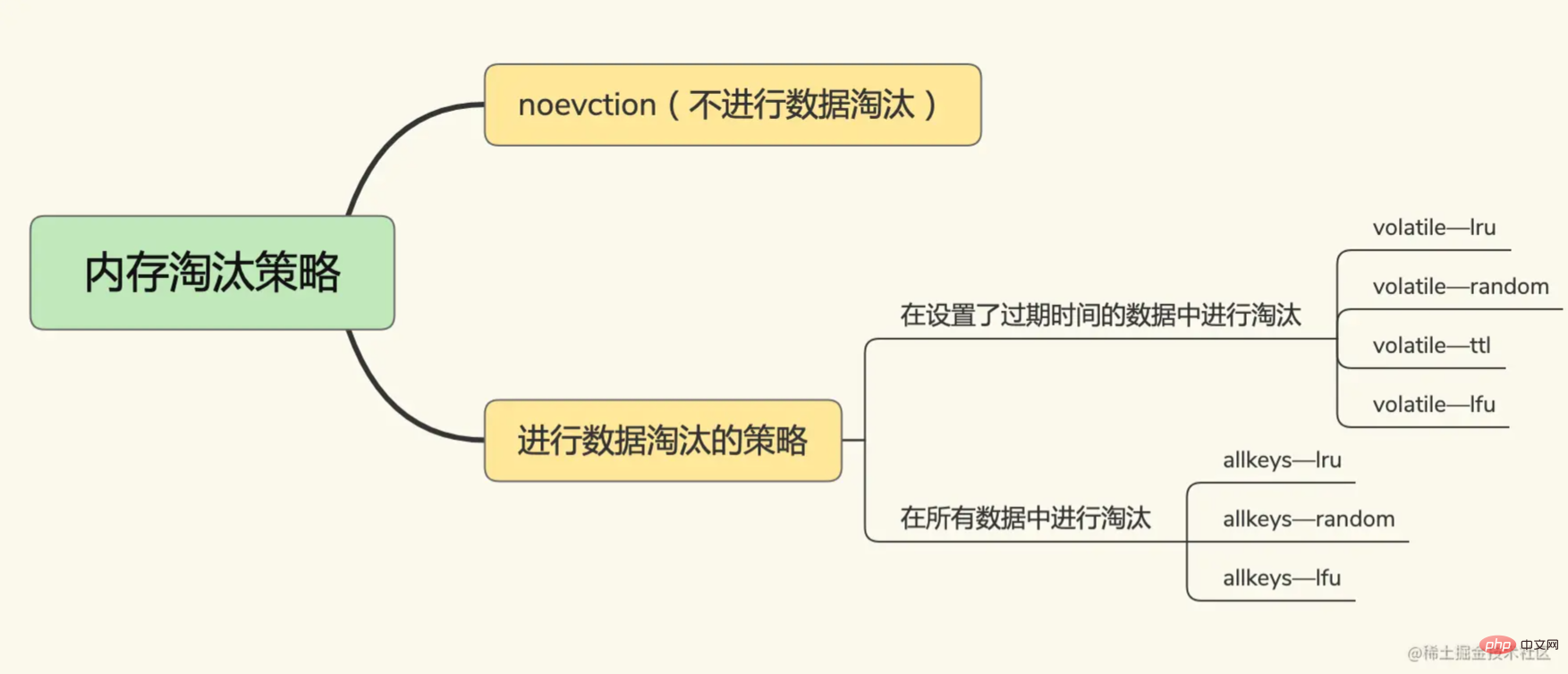A brief analysis of 8 elimination strategies in Redis cache
This article will take you to talk about 8 elimination strategies in Redis and see how to use them. I hope it will be helpful to everyone!

We know that Redis cache uses memory to save data, but the memory size is limited after all. As the amount of data to be cached increases, the limit The cache space will inevitably be filled up. At this time, the cache elimination strategy is needed to delete the data. [Related recommendations: Redis Video Tutorial]
Redis Cache Elimination Strategy
Redis’ elimination strategy can be determined based on whether data will be eliminated. They are divided into two categories:
- The only strategy that does not eliminate data is noeviction.
- 7 other strategies that will be eliminated.
There are 7 strategies for elimination. We can further divide them into two categories according to the scope of the elimination candidate data set:
After setting expiration Eliminated from the time data, including volatile-random, volatile-ttl, volatile-lru, volatile-lfu (newly added after Redis 4.0).
Elimination is performed in all data ranges, including allkeys-lru, allkeys-random, and allkeys-lfu (newly added after Redis 4.0).

Before redis3.0, the default is volatile-lru; after redis3.0 (including 3.0), the default The elimination strategy is noeviction
noeviction strategy
noeviction means not to eliminate data. When the cache data is full and new write requests come in, Redis no longer provides services, but returns errors directly.
Elimination strategy based on expiration time
The four strategies of volatile-random, volatile-ttl, volatile-lru, and volatile-lfu are for those with expiration time set Key-value pairs. When the expiration time of the key-value pair is reached or the Redis memory usage reaches the maxmemory threshold, Redis will eliminate the key-value pair according to these policies;
- volatile-ttl in When filtering, the key-value pairs with expiration time set will be deleted according to the order of expiration time. The earlier the expiration time is, the earlier it will be deleted.
- volatile-random, just like its name, randomly deletes key-value pairs with expiration time set.
- volatile-lru will use the LRU algorithm to filter key-value pairs with an expiration time set.
- volatile-lfu will use the LFU algorithm to select key-value pairs with an expiration time set.
Elimination strategies within all data ranges
allkeys-lru, allkeys-random, allkeys-lfu The data range eliminated by these three strategies is expanded to all Key-value pairs, regardless of whether these key-value pairs have an expiration time set, the rules for filtering data for elimination are:
allkeys-random strategy, randomly select and Delete data;
allkeys-lru strategy uses the LRU algorithm to filter all data.
allkeys-lfu strategy, uses the LFU algorithm to filter across all data.
About the LRU algorithm
The LRU algorithm is the most commonly used algorithm recently, because LRU uses a linked list to maintain the used data list. When more data is used, it will take more time to move elements, which will inevitably affect the Redis main thread. For this reason, Redis has made some simplifications of the lru algorithm.
The core idea of the LRU strategy: If a piece of data has just been accessed, then the data must be hot data and will be accessed again.
According to this core idea, the LRU strategy in Redis will set an lru field in the RedisObject structure corresponding to each data to record the access timestamp of the data. When performing data elimination, the LRU strategy will eliminate the data with the smallest lru field value (that is, the data with the longest access time) in the candidate data set.
So, in business scenarios where data is frequently accessed, the LRU strategy can indeed effectively retain the data with the latest access time. Moreover, because the retained data will be accessed again, the access speed of business applications can be improved.
The specific method is that when accessing a key-value pair, redis will record the timestamp of the most recent access. When redis decides to eliminate data, it will randomly select N data, use them as a candidate set, and filter out the smallest timestamp. When data is eliminated next time, data with a timestamp value smaller than that of the candidate set selected for the first time will be selected and entered into a new candidate set. When the data reaches maxmemory-samples, the smallest value is eliminated.
You can set the number of selected candidate sets through this commandCONFIG SET maxmemory-samples N
Usage recommendations
Based on the strategy With its characteristics, different strategies can be selected to eliminate data for different scenarios.
- When the cached data is not obviously hot or cold, that is, the access frequency of the data is not very different, it is recommended to use
allkeys-randomrandom strategy to eliminate the data; - When the data There are obvious differences between hot and cold. It is recommended to use the
allkeys-lruorvolatile-lrualgorithm to keep the most recently accessed data in the cache data; - When there is a demand for top-level data in the business, that is, data that will not expire, generally no expiration time will be set, and the
volatile-lrustrategy can be used. In this way, this type of data will not be eliminated, but other data can be eliminated according to LRU rules.
For more programming-related knowledge, please visit: Introduction to Programming! !
The above is the detailed content of A brief analysis of 8 elimination strategies in Redis cache. For more information, please follow other related articles on the PHP Chinese website!

Hot AI Tools

Undresser.AI Undress
AI-powered app for creating realistic nude photos

AI Clothes Remover
Online AI tool for removing clothes from photos.

Undress AI Tool
Undress images for free

Clothoff.io
AI clothes remover

Video Face Swap
Swap faces in any video effortlessly with our completely free AI face swap tool!

Hot Article

Hot Tools

Notepad++7.3.1
Easy-to-use and free code editor

SublimeText3 Chinese version
Chinese version, very easy to use

Zend Studio 13.0.1
Powerful PHP integrated development environment

Dreamweaver CS6
Visual web development tools

SublimeText3 Mac version
God-level code editing software (SublimeText3)

Hot Topics
 How to build the redis cluster mode
Apr 10, 2025 pm 10:15 PM
How to build the redis cluster mode
Apr 10, 2025 pm 10:15 PM
Redis cluster mode deploys Redis instances to multiple servers through sharding, improving scalability and availability. The construction steps are as follows: Create odd Redis instances with different ports; Create 3 sentinel instances, monitor Redis instances and failover; configure sentinel configuration files, add monitoring Redis instance information and failover settings; configure Redis instance configuration files, enable cluster mode and specify the cluster information file path; create nodes.conf file, containing information of each Redis instance; start the cluster, execute the create command to create a cluster and specify the number of replicas; log in to the cluster to execute the CLUSTER INFO command to verify the cluster status; make
 How to read redis queue
Apr 10, 2025 pm 10:12 PM
How to read redis queue
Apr 10, 2025 pm 10:12 PM
To read a queue from Redis, you need to get the queue name, read the elements using the LPOP command, and process the empty queue. The specific steps are as follows: Get the queue name: name it with the prefix of "queue:" such as "queue:my-queue". Use the LPOP command: Eject the element from the head of the queue and return its value, such as LPOP queue:my-queue. Processing empty queues: If the queue is empty, LPOP returns nil, and you can check whether the queue exists before reading the element.
 How to clear redis data
Apr 10, 2025 pm 10:06 PM
How to clear redis data
Apr 10, 2025 pm 10:06 PM
How to clear Redis data: Use the FLUSHALL command to clear all key values. Use the FLUSHDB command to clear the key value of the currently selected database. Use SELECT to switch databases, and then use FLUSHDB to clear multiple databases. Use the DEL command to delete a specific key. Use the redis-cli tool to clear the data.
 How to configure Lua script execution time in centos redis
Apr 14, 2025 pm 02:12 PM
How to configure Lua script execution time in centos redis
Apr 14, 2025 pm 02:12 PM
On CentOS systems, you can limit the execution time of Lua scripts by modifying Redis configuration files or using Redis commands to prevent malicious scripts from consuming too much resources. Method 1: Modify the Redis configuration file and locate the Redis configuration file: The Redis configuration file is usually located in /etc/redis/redis.conf. Edit configuration file: Open the configuration file using a text editor (such as vi or nano): sudovi/etc/redis/redis.conf Set the Lua script execution time limit: Add or modify the following lines in the configuration file to set the maximum execution time of the Lua script (unit: milliseconds)
 How to use the redis command line
Apr 10, 2025 pm 10:18 PM
How to use the redis command line
Apr 10, 2025 pm 10:18 PM
Use the Redis command line tool (redis-cli) to manage and operate Redis through the following steps: Connect to the server, specify the address and port. Send commands to the server using the command name and parameters. Use the HELP command to view help information for a specific command. Use the QUIT command to exit the command line tool.
 How to set the redis expiration policy
Apr 10, 2025 pm 10:03 PM
How to set the redis expiration policy
Apr 10, 2025 pm 10:03 PM
There are two types of Redis data expiration strategies: periodic deletion: periodic scan to delete the expired key, which can be set through expired-time-cap-remove-count and expired-time-cap-remove-delay parameters. Lazy Deletion: Check for deletion expired keys only when keys are read or written. They can be set through lazyfree-lazy-eviction, lazyfree-lazy-expire, lazyfree-lazy-user-del parameters.
 How to optimize the performance of debian readdir
Apr 13, 2025 am 08:48 AM
How to optimize the performance of debian readdir
Apr 13, 2025 am 08:48 AM
In Debian systems, readdir system calls are used to read directory contents. If its performance is not good, try the following optimization strategy: Simplify the number of directory files: Split large directories into multiple small directories as much as possible, reducing the number of items processed per readdir call. Enable directory content caching: build a cache mechanism, update the cache regularly or when directory content changes, and reduce frequent calls to readdir. Memory caches (such as Memcached or Redis) or local caches (such as files or databases) can be considered. Adopt efficient data structure: If you implement directory traversal by yourself, select more efficient data structures (such as hash tables instead of linear search) to store and access directory information
 How to implement redis counter
Apr 10, 2025 pm 10:21 PM
How to implement redis counter
Apr 10, 2025 pm 10:21 PM
Redis counter is a mechanism that uses Redis key-value pair storage to implement counting operations, including the following steps: creating counter keys, increasing counts, decreasing counts, resetting counts, and obtaining counts. The advantages of Redis counters include fast speed, high concurrency, durability and simplicity and ease of use. It can be used in scenarios such as user access counting, real-time metric tracking, game scores and rankings, and order processing counting.






